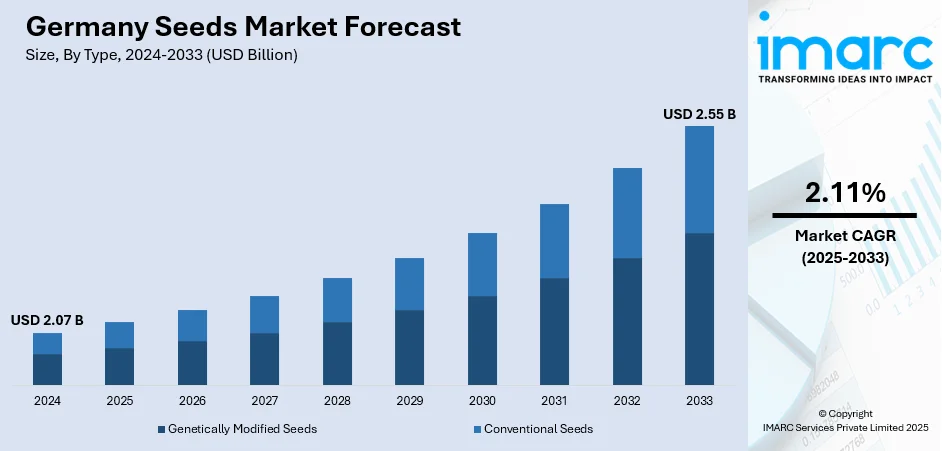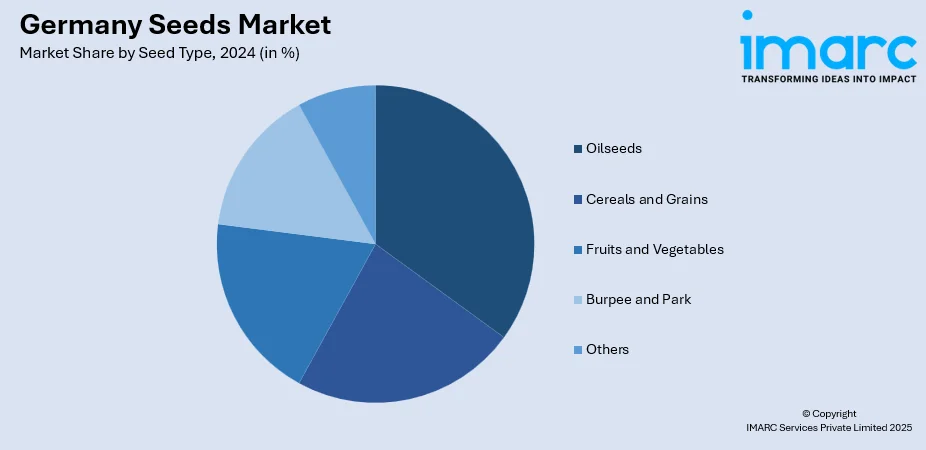
Germany Seeds Market Size, Share, Trends and Forecast by Type, Seed Type, Traits, Availability, Seed Treatment, and Region, 2025-2033
Germany Seeds Market Overview:
The Germany seeds market size reached USD 2.07 Billion in 2024. The market is projected to reach USD 2.55 Billion by 2033, exhibiting a growth rate (CAGR) of 2.11% during 2025-2033. The market is evolving with increased focus on innovation, sustainable agriculture, and advanced seed treatments. Diverse seed types and traits are being developed to meet the demands of various crops and farming conditions across different regions. Availability improvements and technological advancements are driving adoption among growers. The market’s growth is supported by strategic collaborations and research investments aimed at enhancing seed quality and crop productivity. These factors collectively influence the competitive landscape and future opportunities within the Germany seeds market share.
|
Report Attribute
|
Key Statistics
|
|---|---|
|
Base Year
|
2024
|
|
Forecast Years
|
2025-2033
|
|
Historical Years
|
2019-2024
|
| Market Size in 2024 | USD 2.07 Billion |
| Market Forecast in 2033 | USD 2.55 Billion |
| Market Growth Rate 2025-2033 | 2.11% |
Germany Seeds Market Trends:
Technological Integration Accelerates Seed Quality
In January 2025, the sources reported that rapeseed was planted across approximately 1,100,000 hectares nationwide, reflecting a notable expansion in oilseed crop area. This increase isn’t just about land use it signals growing demand for climate-resilient seed varieties that align with the needs of Germany’s biofuel, food, and livestock sectors. Digital phenotyping and satellite-supported diagnostics are becoming central tools in seed quality assessment. Meanwhile, newer seed coating methods and micro-treatment technologies are improving germination consistency under shifting weather conditions. With precision-agriculture tools now informing seed selection, farmers are optimizing variety performance based on local soil and weather data. This is leading to more consistent outcomes in both yield and input use. Certified seed adoption is steadily climbing as producers prioritize performance traits and reliability. Collectively, these technology-led innovations are transforming seed usage, boosting both adaptability and efficiency. These developments are playing a critical role in shaping the trajectory of Germany seeds market growth, reinforcing quality as a core competitive advantage.

To get more information on this market, Request Sample
Sustainability-Driven Seed Demand Grows
In 2024, approximately 19,017.7 hectares of vegetables and strawberries were cultivated under certified organic practices in Germany, according to the sources. This steady rise in organic acreage reflects a broader shift toward sustainability across the German agricultural sector. Farmers are increasingly looking for seed varieties that can perform well without synthetic fertilizers or pesticides. As a result, there’s growing demand for open-pollinated and climate-resilient cultivars specifically suited to organic soil and weather conditions. Biological seed coatings and natural inoculants are gaining ground, helping young plants establish quickly under low-input systems. Public initiatives supporting biodiversity and soil regeneration further encourage this transition, creating favorable conditions for seed innovation aligned with eco-farming models. Suppliers are adapting by investing in breeding programs for seeds tailored to organic guidelines, while farmers respond to both environmental and market incentives. The organic seed landscape now prioritizes ecological resilience, soil restoration, and adherence to certification norms. Altogether, these shifts represent one of the most significant Germany seeds market trends shaping the future of food production.
Protein Crop Seed Production Picks Up Steam
In May 2025, sources indicated an anticipated increase in acreage for protein crops such as peas and soybeans in the coming harvest. This expansion strategically aims to boost local protein crop output and reduce dependency on soybean imports. Protein crops are essential in crop rotation schemes, which help to provide soil nitrogen enrichment and promote sustainable agriculture. Seed producers and breeders are responding with varieties adapted to the local climate and soil conditions, enhancing disease resistance and yield stability. Together with this, there is increased emphasis on achieving EU targets on sustainability, for example, the Green Deal, which promotes biodiversity and less agricultural emissions. The outcome is an increasingly diversified seed offer, including legumes, that is better for farmers and the environment. These seeds are drawing significant investment in both technology and quality assurance to meet rising demand. Overall, these advances in seeds of protein crops not only aid ecologically oriented farming objectives but also enhance Germany's seed industry both domestically as well as export-wise, supporting growth.
Germany Seeds Market Segmentation:
IMARC Group provides an analysis of the key trends in each segment of the market, along with forecasts at the country and regional levels for 2025-2033. Our report has categorized the market based on type, seed type, traits, availability, and seed treatment.
Type Insights:
- Genetically Modified Seeds
- Conventional Seeds
The report has provided a detailed breakup and analysis of the market based on the type. This includes genetically modified seeds and conventional seeds.
Seed Type Insights:

- Oilseeds
- Soybean
- Sunflower
- Cotton
- Canola/Rapeseed
- Cereals and Grains
- Corn
- Wheat
- Rice
- Sorghum
- Fruits and Vegetables
- Tomatoes
- Lemons
- Brassica
- Pepper
- Lettuce
- Onion
- Carrot
- Burpee and Park
- Others
A detailed breakup and analysis of the market based on the seed type have also been provided in the report. This includes oilseeds (soybean, sunflower, cotton, and canola/rapeseed), cereals and grains (corn, wheat, rice, and sorghum), fruits and vegetables (tomatoes, lemons, brassica, pepper, lettuce, onion, and carrot), burpee and park, and others.
Traits Insights:
- Herbicide-Tolerant (HT)
- Insecticide-Resistant (IR)
- Others
The report has provided a detailed breakup and analysis of the market based on the traits. This includes herbicide-tolerant (HT), insecticide-resistant (IR), and others.
Availability Insights:
- Commercial Seeds
- Saved Seeds
A detailed breakup and analysis of the market based on the availability have also been provided in the report. This includes commercial seeds and saved seeds.
Seed Treatment Insights:
- Treated
- Untreated
The report has provided a detailed breakup and analysis of the market based on the seed treatment. This includes treated and untreated.
Regional Insights:
- Western Germany
- Southern Germany
- Eastern Germany
- Northern Germany
The report has also provided a comprehensive analysis of all the major regional markets, which include the Western Germany, Southern Germany, Eastern Germany, and Northern Germany.
Competitive Landscape:
The market research report has also provided a comprehensive analysis of the competitive landscape. Competitive analysis such as market structure, key player positioning, top winning strategies, competitive dashboard, and company evaluation quadrant has been covered in the report. Also, detailed profiles of all major companies have been provided.
Germany Seeds Market News:
- April 2025: KWS Seeds, headquartered in Einbeck, Germany, has commenced construction on a state-of-the-art research facility in Kimberly, Idaho, USA. This facility aims to enhance the performance, profitability, and sustainability of sugar beet farming. The project includes two advanced greenhouse structures equipped with innovative vernalization chambers, enabling precise control over temperature, humidity, and light conditions. These enhancements will support the development of improved sugar beet varieties, focusing on disease resistance and herbicide tolerance.
- June 2024: Bayer, headquartered in Germany, has partnered with Dutch company Solynta to introduce hybrid true potato seeds in Kenya and India. This collaboration marks Bayer's entry into the global potato market, focusing on smallholder farmers in remote regions. The true potato seeds offer advantages over traditional seed tubers, including reduced logistical challenges and improved disease control. Bayer will leverage its distribution networks in these countries to commercialize Solynta's hybrid potato varieties, aiming to enhance food and nutritional security.
Germany Seeds Market Report Coverage:
| Report Features | Details |
|---|---|
| Base Year of the Analysis | 2024 |
| Historical Period | 2019-2024 |
| Forecast Period | 2025-2033 |
| Units | Billion USD |
| Scope of the Report |
Exploration of Historical Trends and Market Outlook, Industry Catalysts and Challenges, Segment-Wise Historical and Future Market Assessment:
|
| Types Covered | Genetically Modified Seeds, Conventional Seeds |
| Seed Types Covered |
|
| Traits Covered | Herbicide-Tolerant (HT), Insecticide-Resistant (IR), Others |
| Availabilities Covered | Commercial Seeds, Saved Seeds |
| Seed Treatments Covered | Treated, Untreated |
| Regions Covered | Western Germany, Southern Germany, Eastern Germany, Northern Germany |
| Customization Scope | 10% Free Customization |
| Post-Sale Analyst Support | 10-12 Weeks |
| Delivery Format | PDF and Excel through Email (We can also provide the editable version of the report in PPT/Word format on special request) |
Key Questions Answered in This Report:
- How has the Germany seeds market performed so far and how will it perform in the coming years?
- What is the breakup of the Germany seeds market on the basis of type?
- What is the breakup of the Germany seeds market on the basis of seed type?
- What is the breakup of the Germany seeds market on the basis of traits?
- What is the breakup of the Germany seeds market on the basis of availability?
- What is the breakup of the Germany seeds market on the basis of seed treatment?
- What is the breakup of the Germany seeds market on the basis of region?
- What are the various stages in the value chain of the Germany seeds market?
- What are the key driving factors and challenges in the Germany seeds market?
- What is the structure of the Germany seeds market and who are the key players?
- What is the degree of competition in the Germany seeds market?
Key Benefits for Stakeholders:
- IMARC’s industry report offers a comprehensive quantitative analysis of various market segments, historical and current market trends, market forecasts, and dynamics of the Germany seeds market from 2019-2033.
- The research report provides the latest information on the market drivers, challenges, and opportunities in the Germany seeds market.
- Porter's five forces analysis assist stakeholders in assessing the impact of new entrants, competitive rivalry, supplier power, buyer power, and the threat of substitution. It helps stakeholders to analyze the level of competition within the Germany seeds industry and its attractiveness.
- Competitive landscape allows stakeholders to understand their competitive environment and provides an insight into the current positions of key players in the market.
Need more help?
- Speak to our experienced analysts for insights on the current market scenarios.
- Include additional segments and countries to customize the report as per your requirement.
- Gain an unparalleled competitive advantage in your domain by understanding how to utilize the report and positively impacting your operations and revenue.
- For further assistance, please connect with our analysts.
 Request Customization
Request Customization
 Speak to an Analyst
Speak to an Analyst
 Request Brochure
Request Brochure
 Inquire Before Buying
Inquire Before Buying




.webp)




.webp)












